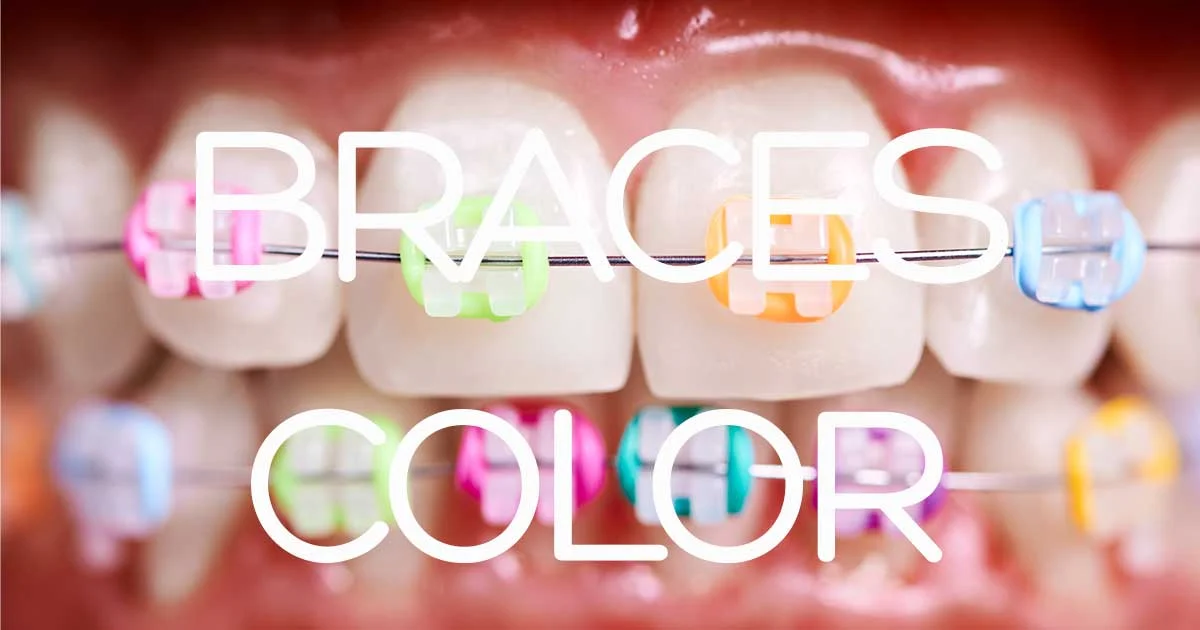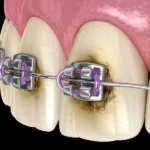Braces Colors

Adding braces colors alleviates the classic stereotype of traditional, boring, silver metal braces. Why not add a pop of color to your braces? After all, you are going to be wearing them for a couple of years anyway. There are a few colors to choose from. You can choose one color, two colors, or three colors.
Table of Contents
How Is Color Added to Braces?
The bands (elastic ligatures) that hold the braces together come in a variety of colors. Colored braces can turn your smile into a fashion statement or an expression of your personal style which can make a huge difference. Red, green, and blue are the standard ones, but more and more orthodontists are offering a much wider variety of colors to suit anyone’s style.
These elastic bands get changed with every orthodontist visit you go to every 4-6 weeks. With that in mind, you can switch up your color each time you visit your orthodontist. No more stressing about which color to select now that you know you don’t have to choose one set of colors for the whole duration of the treatment.
Ceramic and Invisalign are an option for those who would not like to draw attention to their dental work. These are also dental braces to keep your braces as invisible as possible. With the two choices mentioned, there is no need to opt for color because these choices don’t support them and going ‘colorless’ is the main focus of the options.
There are many reasons to choose clear braces. One reason is that they can boost self-esteem and confidence during treatment. Clients can attend school, partake in social events, and work customer-facing jobs without having their treatment devices display so obviously.
Another reason to choose clear braces is for the cosmetic novelty. Teeth-colored braces are highly fashionable and trendy. They’re an enjoyable option for clients in any age bracket. This innovative option proves that orthodontic care is not at all uptight, dreadful, or unattractive. Patients all over the world are excited about choices like clear braces because they’re fun, and they allow them to correct their teeth discreetly.
What to Consider When Choosing Your Colors?
The most common colors to choose from are basic colors such as red, blue, green, yellow, purple, pink, orange, gray, silver, gold, and black. These colors can range from light to dark shades depending on what colors you want and what pattern you want them in. The first thing to consider when choosing colors for your braces is color perception. Color perception can be perceived as taking your desired color into account when choosing colors for braces. For example, skin tones play a part in choosing the colors for your braces and pulling off the look.
If you have a light skin tone colors like light and dark blue, bronze, dark purple and certain tones of red and pink will look desirable and compliment your skin tone. For darker skin tones you may want to consider colors such as gold, turquoise, orange, green, violet, pink, and dark blue. You may have to experiment by thinking of relevant color matchups in your head. You can also compare colors side by side.
Braces color for girls: If you are a female, you can experiment with colors by using eyeshadow. Once you find a color that compliments your eyes, you can consider using the color for your braces.
Braces color for Boys: For a male, you may want to consider certain scenarios such as colors of clothing that you wear frequently.
Darker colors make your teeth appear whiter. Lighter colors may make your teeth appear more yellow. If you are not happy with your initial choice of colors, you can always switch up your colors as the seasons change. For instance, Valentine’s day (red), Christmas (green and red), Easter (pink), St. Patrick’s Day (green), 4th of July (red, white, and blue), Halloween (glow in the dark bands that appear clear until you cut off the light) and so forth. If you are in school, you can consider changing your braces to match your school colors or support your favorite sports team.
What Color of Braces should You Avoid?
A few things to steer clear of certain include colors that cause your teeth to look like there are food particles stuck in between. Colors like black, green, or brown can give people around you the wrong impression. If you choose these colors it may look like you have food in your teeth which no one wants. Choosing the color black for braces can be a hit or miss depending if you want to mix the color black or choose black as the only color for your elastics.
Braces Colors Ideas
- Favorite color: You can consider your personal taste. If your braces have connected elastic ligatures, you are limited to one color. If you have the more traditional single elastic, then you can have a rainbow of colors.
- Holidays and Events: You can consider your national flag, the colors of your favorite sport team, etc. Some dentists might even have all of the colors of the rainbow. Or you can just pick color(s) that you like. If you are taking your child to the orthodontist, letting them pick their own colors can make everything less stressful. Kids may choose ridiculous colors, but let them express themselves. Braces suck enough without an adult telling you you can’t have hot pink if you want. Many teenagers like to choose their favorite color or their school’s colors.
Before your appointment, ask if your orthodontist has a color palette or color wheel. It’s best to look at their wheel as not all orthodontists offer the same colors, but there are a variety of online color pickers that will show you what they look like on a sample mouth. You can also ask what brand your orthodontist uses, and then look at the brand’s website for available colors. By looking at the colors in advance you can think things through, look at your wardrobe, etc, rather than being on the spot in the chair. Colors tend to look darker on screen and lighter when actually on your teeth, so go for a shade darker than you think you want. Choosing in advance is less stressful and will make sure that colored braces do not add to the length of your appointment. The orthodontist will appreciate a head’s up so they can have the right bands handy. For unusual colors they may even have to order them, or they may be running low on a color and need the time to order more. It might be a good idea to have a backup color in mind in case there is a supply problem at the time of your appointment. Once at your appointment, confirm your color choice with your orthodontist and double check that they have it right so you get the smile you want.
Do Clear Braces Turn Yellow?
Even the color white has its downfalls too. White may seem like a solid color that some people may want but should avoid. White is the color that teeth should be so of course if you choose white elastics the color will be compared to your teeth. Choosing the color white for your braces may make your teeth appear to be more yellow than they are if your teeth are not already whitened. To make things a little more complex, white elastics stain a little easier than any color. The last color you should avoid is yellow. If your teeth are white, yellow elastic may make your teeth appear to be yellow. If your enamel has even the slightest bit of yellow, yellow elastics may amplify this effect. Either way, you may be able to get away with adding yellow to braces if you do it in a tasteful manner or pattern.
How to Pick the Best Braces Color?
There are several things you should take into account when choosing the color of your braces:
- The color of your teeth. If you have very white teeth, they will look even whiter if you choose black, dark purple, navy, or another dark color. If your teeth are yellow, then clear or silver bands look best, but avoid yellow and gold, which will make them look even yellower.
- Clear and white bands can stain easily and take on the color of your food. If you smoke or drink a lot of coffee this will be even worse, turning the bands ugly yellow or brown.
- Take into account your skin and hair color. Darker skin can look best with dark blue, turquoise, or orange. Light complexion and hair looks best in colors such as raspberry, plum, and bluish red. Think about colors that look good on you in general. Light green bands complement brown eyes well, while blue eyes can look good with blue, pink, and lilac.
- Think about your wardrobe. If you have colors you constantly go back to, then pick one of those colors. If your wardrobe is all over the place, then go for a neutral color that goes with anything.
- Avoid dark green and dark brown, both of which can look from any distance as if you have food stuck in your teeth. The same issue can happen over time with clear or white bands. If you find that this happens to you, or if you drink a lot of coffee, tea, or dark colored soda, then change to a new color at your next appointment.
- Avoid colors you simply don’t like, even if somebody else thinks they look good on you. Having braces in your mouth can be embarrassing enough. Making them something you want to show off helps, but choosing a color you want to hide will just result in ugly close-mouthed smiles.
February 15, 2023What Is The Average Cost Of Braces In Houston?
July 26, 2022Should I Have My Wisdom Teeth Removed Before I Get Braces?
September 23, 2021Pain After Braces
September 15, 2021how much does invisalign cost?





